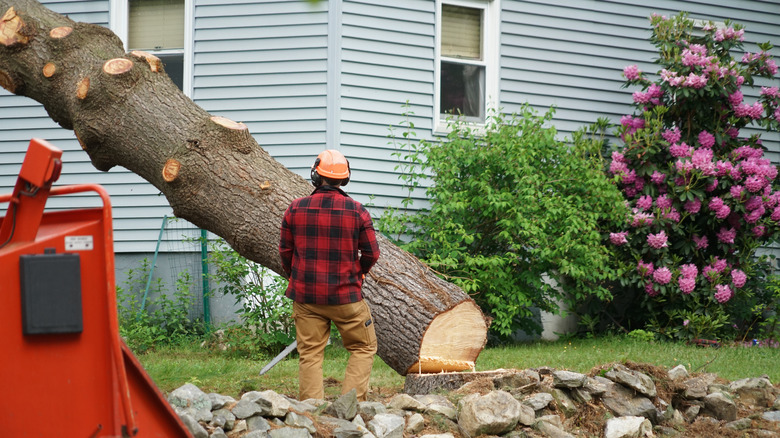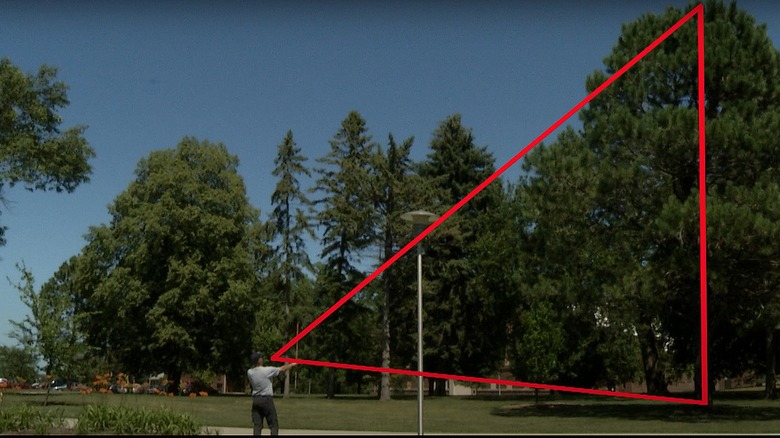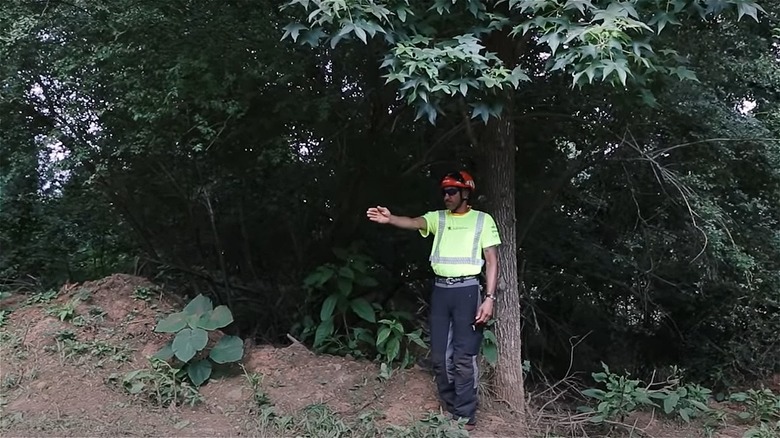The Trick For Safely Cutting Down A Tree Without Damaging Your Home Or Yard
There are multiple reasons, like safety, diseased limbs, and aesthetics, why you would want to topple the majestic sentinels gracing your yard. Sadly, undertaking this endeavor isn't innocuous, as it's infamous for causing severe injuries and, at worst, the deaths of loggers. According to the American Journal of Industrial Medicine, accidental tree-felling caused 314 mortalities between 2010 and 2020, with most victims getting struck by broken boughs. One way to minimize this problem is to accurately estimate your tree's total height, as it's proportional to the ground it will take up after being axed.
While you could use tools like hypsometers or mobile apps to get a rough approximation, the "stick or ax trick" works better in assessing your tree's apex. Simply put, put a stick at your eye level and adjust your position until you perceive the stick's two ends match the tree's base and canopy. Your final position defines the felling zone, although it's best to keep an extra margin for errors. That being said, don't dither on safety gear, during the assessment exercise and while cutting the trees down. Also, have two retreat routes handy — opposite diagonally, at an angle of 45 degrees — in case the cut portion doesn't descend as planned. Remember the 90-15-5 rule — 90% of the incidents happen in under 15 seconds inside 5 feet of the fall radius.
Performing the stick trick
Before you cut the notch in your tree, get an idea of how far out the tree will drop. This should clarify if there are any barriers or debris that you must clear out beforehand. But if you think the falling trunk may encounter overhanging electric wires or fall onto neighboring trees, call a tree service specialist for the job. If you still want to DIY, take a stick (or an ax) as long as the distance between your eye and the outstretched hand.
Level the stick at your eye level such that the terminal end hovers about 1 foot above the tree's base, as this is where you'd usually make the notch cut. Maintain your stretched position and rotate the stick upward by 90 degrees. Stiffly move closer or farther away from the tree till the stick's top end levels with the tree's top. Mark your position by pushing the stick into the ground to measure the distance to the tree. While it's believed this distance equals the tree's height, you're better off adding your height to the previous estimate. So, if the original distance is 60 feet and you're 6 feet tall, your tree will most likely fall within the 66-foot zone.
Make adjustments for leanness and terrain
While the trick works well for straight trees growing on flat ground, things get tricky if they lean over 5 degrees. To determine if your tree leans, get a plumb line, and tie a nut at its terminal end. Line it up with the tree's canopy, and estimate the distance between the nut and the trunk's center at ground level. If they don't overlap, your tree has a tilting problem. You can find the inclination using your hands, too.
Face the tree in the direction of where you plan to cut the notch, cup your hands in a circle, and walk back until the circle completely encapsulates the treetop. Bring your hands down to mark your position and calculate its distance from the tree's base. Move perpendicular to the felling line and repeat the process. If both positions yield over a 3-foot distance, return to the drawing board and find a different felling direction. But if it's under 3 feet, adjust per the leaning direction. Lower the height for the trees bending forward and raise it for the ones bent backward. Besides the natural lean, pay attention to the slope. While it's ideal for toppling the trees uphill, your stick-based approximation will likely be low and must be adjusted upward. The converse holds if deposing downhill. Finally, factor in the wind direction and the tree's condition before cutting, as strong gusts and rotten trunks can play spoilsport.


